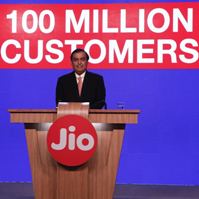 
In June 2003, when Mukesh Ambani announced ‘Monsoon Hungama’ offer to attract customers, Reliance Infocomm (now RCOM) emerged as a big threat to incumbent service providers. It soon became the second largest operator in India in terms of subscriber base. Interestingly, in the 2G era its technology (CDMA) had superior data capabilities compared to GSM.
However, RCOM was soon branded as low tariff, low quality operator. It was not able to attract high end customers. Now, RCOM is a small operator with a market cap of Rs 8,000 crore.
It will be interesting to observe whether Mukesh Ambani’s second telecom venture Reliance Jio will be able to attract high end customers. Ambani today announced that customers will be required to pay Rs 303 per month for daily data usage of 1GB and unlimited voice calls. There will be a premium charge of Rs 99 per annum.
The 20:80 rule of management that Ambani invoked in his last press conference is valid for the paying customers also. If Jio wants to become a large player in long run, it will have to rope in the top 20% subscribers. They will not be attracted by low tariff. They want good quality of services, especially voice that is primary need of a subscriber.
There is no doubt that Jio’s tariff plan will put pressure on its competitors – Airtel, Idea and Vodafone. They will have to lower prices and improve quality of services.
Interestingly, the incumbent operators are adding large number of new subscribers every month even though Reliance Jio is offering free services. Airtel, Vodafone and Idea added 2.5, 1.9 and 2.8 million subscribers in December, 2016. At the same time, it is highly unlikely that the high end customers have shifted to Jio due to poor quality of voice.
Jio has managed to impact revenue of all the Telcos. Airtel’s Q3 profits fell by 54% to Rs 500 crore. Incumbents will have to rework their strategies. |